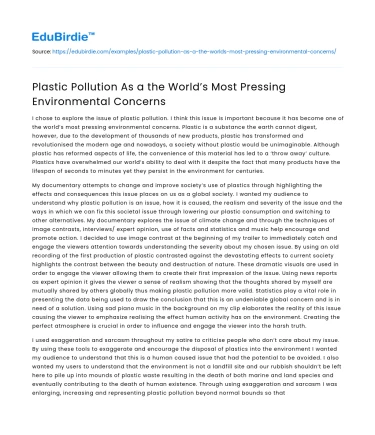Introduction
Plastic pollution has emerged as one of the most severe environmental challenges of the 21st century. The proliferation of plastic products has revolutionized modern life, providing convenience and durability at low costs. However, this comes at a significant environmental expense. According to the United Nations Environment Programme, approximately 300 million tons of plastic are produced globally each year, with a significant portion ending up in oceans and landfills. The ubiquity and persistence of plastic waste have far-reaching implications for ecosystems, wildlife, and human health. This essay explores the multifaceted nature of plastic pollution, its impact on the environment, and the urgent need for comprehensive solutions. In doing so, it examines the ecological consequences, evaluates current mitigation strategies, and considers the role of policy and innovation in addressing this pressing issue.
Ecological Consequences of Plastic Pollution
Plastic pollution poses a substantial threat to marine and terrestrial ecosystems. Fragmentation of plastic waste into microplastics, particles less than five millimeters in size, has been detected in every corner of the globe, from the depths of the Mariana Trench to the Arctic ice. These microplastics are ingested by marine organisms, entering the food chain and impacting biodiversity. A study published in Nature reported that over 700 marine species are affected by plastic debris, often leading to fatalities due to ingestion or entanglement. The deleterious effects extend to humans, as microplastics have been found in drinking water and food, raising concerns about potential health risks.
Moreover, plastic pollution disrupts terrestrial ecosystems. Landfills, often the final destination for plastic waste, leach harmful chemicals into the soil and groundwater, affecting plant and animal life. According to the World Wildlife Fund, the long-term degradation of landscapes due to plastic accumulation can lead to habitat loss and decreased soil fertility. These ecological disruptions underscore the need for urgent action to mitigate plastic pollution.
Current Mitigation Strategies and Their Limitations
Efforts to combat plastic pollution have gained momentum in recent years, with initiatives ranging from grassroots movements to international agreements. The European Union's ban on single-use plastics and China's National Sword policy, which restricts the import of foreign waste, represent significant policy efforts. Furthermore, numerous organizations advocate for a circular economy model, emphasizing recycling and sustainable production practices. Despite these measures, the efficacy of current strategies is often limited by inadequate infrastructure, lack of public awareness, and economic constraints.
Recycling, a cornerstone of many anti-plastic initiatives, faces significant challenges. According to the Environmental Protection Agency, only 9% of plastic waste in the United States is recycled, with the rest incinerated or sent to landfills. The variability in plastic composition and contamination issues complicate recycling processes, reducing efficiency. Moreover, the economic viability of recycling operations remains a barrier, as virgin plastic often proves cheaper than recycled alternatives. These limitations highlight the need for innovative solutions and more robust policy frameworks.
The Role of Policy and Innovation in Overcoming Plastic Pollution
Addressing plastic pollution requires a multifaceted approach that combines policy intervention, technological innovation, and societal change. Governments play a crucial role in enforcing regulations that limit plastic production and promote sustainable alternatives. The implementation of extended producer responsibility (EPR) schemes, which hold manufacturers accountable for the lifecycle of their products, can incentivize the reduction of plastic use and enhance recycling efforts.
Innovation in materials science offers promising avenues for reducing plastic dependency. Biodegradable plastics, derived from renewable sources such as cornstarch and sugarcane, present a viable alternative to traditional plastics. However, widespread adoption of these materials necessitates advancements in production technologies and consumer acceptance. Furthermore, public education campaigns are essential to foster behavioral changes and increase awareness of plastic pollution's impacts. By integrating policy, innovation, and education, a comprehensive strategy can be formulated to combat plastic pollution effectively.
Conclusion
Plastic pollution is undeniably one of the most pressing environmental issues today, with profound implications for ecosystems, wildlife, and human health. While current mitigation strategies have made some headway, they are often hampered by various challenges. To effectively address this crisis, a concerted effort involving policy reform, technological advancement, and societal engagement is required. Governments, industries, and individuals must collaborate to promote sustainable practices and innovative solutions that reduce plastic waste. As the global community becomes increasingly aware of the environmental costs of plastic pollution, it is imperative to act decisively to safeguard the planet for future generations.






 Stuck on your essay?
Stuck on your essay?

